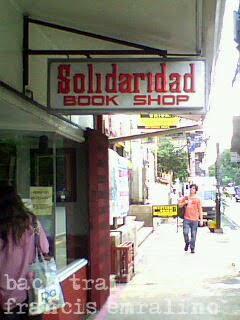It is pretty rare that I go to a place of worship (regardless of religion) to reflect. Most often, I do a visit to marvel at the architecture and the religious artifacts inside the churches. But somehow our accidental visit to Archdiocesan Shrine of St. Joseph (St. Joseph Shrine) Quezon City broke that habit.
We were actually on our way to 70’s Bistro to attend the book launch of a poetry anthology when we stumbled upon this church. A loudspeaker was blaring prayers on the street and it was only but natural to look for a church. I knew it was a church. We entered an entrance and came upon what I believed was the chapel of the saints. Adjacent to it was another chapel but I was sure that the prayers were not coming from of the place.
Temporarily defeated, I decided to proceed to 70’s Bistro but looked up to find stairs leading to another part of the place. It was there that we found the church.

There was already that attraction to the place for despite its location (along a very very busy thoroughfare), you can still reflect, as the noises from the outside are literally cut off by the serene atmosphere and the stained glass windows. It was established on November 23, 1951. The Feast Day of St. Joseph is on March 19.
The schedule of masses are: Monday-Saturday: 5:30 am, 6:15 am, 7:00 am, 7:45 am, 12:00 nn, 6:00 pm, 7:00 pm | Sundays: 5:00 am, 6:00 am, 7:30 am, 9:00 am, 10:30 am, 12:30 nn, 2:00 pm, 3:30 pm, 5:00 pm 6:30 pm, 8:00 pm.
[How to go to Saint Joseph Shrine: If you come from EDSA-Cubao, on the area of the Araneta Coliseum, you can take the LRT and drop off at Anonas Station. The church is just a few steps away from it.]
We were actually on our way to 70’s Bistro to attend the book launch of a poetry anthology when we stumbled upon this church. A loudspeaker was blaring prayers on the street and it was only but natural to look for a church. I knew it was a church. We entered an entrance and came upon what I believed was the chapel of the saints. Adjacent to it was another chapel but I was sure that the prayers were not coming from of the place.
Temporarily defeated, I decided to proceed to 70’s Bistro but looked up to find stairs leading to another part of the place. It was there that we found the church.

* view of the aisle from the stairs
 * the windows
* the windows
 * general view of the church
* general view of the church
 * a painting on the entrance of the church depicting a religious tradition of the Filipinos
* a painting on the entrance of the church depicting a religious tradition of the Filipinos
 * the windows
* the windows * general view of the church
* general view of the church  * a painting on the entrance of the church depicting a religious tradition of the Filipinos
* a painting on the entrance of the church depicting a religious tradition of the Filipinos There was already that attraction to the place for despite its location (along a very very busy thoroughfare), you can still reflect, as the noises from the outside are literally cut off by the serene atmosphere and the stained glass windows. It was established on November 23, 1951. The Feast Day of St. Joseph is on March 19.
The schedule of masses are: Monday-Saturday: 5:30 am, 6:15 am, 7:00 am, 7:45 am, 12:00 nn, 6:00 pm, 7:00 pm | Sundays: 5:00 am, 6:00 am, 7:30 am, 9:00 am, 10:30 am, 12:30 nn, 2:00 pm, 3:30 pm, 5:00 pm 6:30 pm, 8:00 pm.
[How to go to Saint Joseph Shrine: If you come from EDSA-Cubao, on the area of the Araneta Coliseum, you can take the LRT and drop off at Anonas Station. The church is just a few steps away from it.]














































